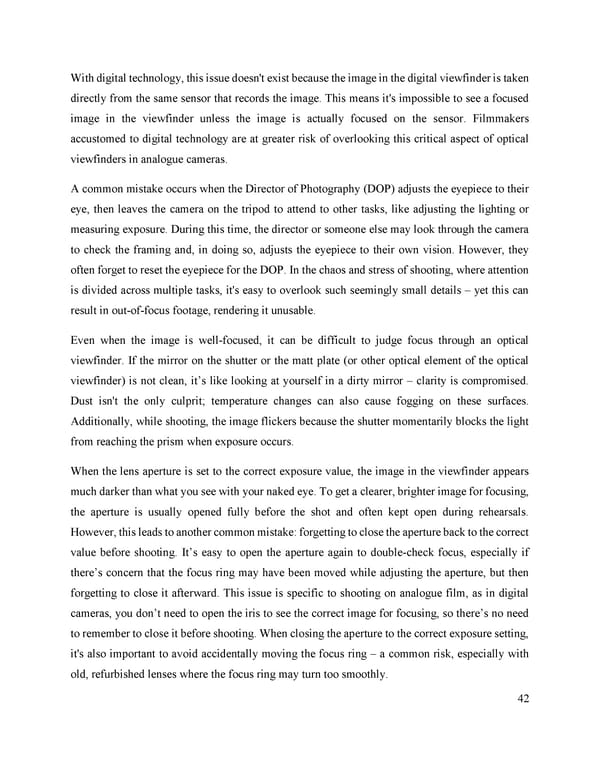With digital technology, this issue doesn't exist because the image in the digital viewfinder is taken directly from the same sensor that records the image. This means it's impossible to see a focused image in the viewfinder unless the image is actually focused on the sensor. Filmmakers accustomed to digital technology are at greater risk of overlooking this critical aspect of optical viewfinders in analogue cameras. A common mistake occurs when the Director of Photography (DOP) adjusts the eyepiece to their eye, then leaves the camera on the tripod to attend to other tasks, like adjusting the lighting or measuring exposure. During this time, the director or someone else may look through the camera to check the framing and, in doing so, adjusts the eyepiece to their own vision. However, they often forget to reset the eyepiece for the DOP. In the chaos and stress of shooting, where attention is divided across multiple tasks, it's easy to overlook such seemingly small details – yet this can result in out-of-focus footage, rendering it unusable. Even when the image is well-focused, it can be difficult to judge focus through an optical viewfinder. If the mirror on the shutter or the matt plate (or other optical element of the optical viewfinder) is not clean, it’s like looking at yourself in a dirty mirror – clarity is compromised. Dust isn't the only culprit; temperature changes can also cause fogging on these surfaces. Additionally, while shooting, the image flickers because the shutter momentarily blocks the light from reaching the prism when exposure occurs. When the lens aperture is set to the correct exposure value, the image in the viewfinder appears much darker than what you see with your naked eye. To get a clearer, brighter image for focusing, the aperture is usually opened fully before the shot and often kept open during rehearsals. However, this leads to another common mistake: forgetting to close the aperture back to the correct value before shooting. It’s easy to open the aperture again to double-check focus, especially if there’s concern that the focus ring may have been moved while adjusting the aperture, but then forgetting to close it afterward. This issue is specific to shooting on analogue film, as in digital cameras, you don’t need to open the iris to see the correct image for focusing, so there’s no need to remember to close it before shooting. When closing the aperture to the correct exposure setting, it's also important to avoid accidentally moving the focus ring – a common risk, especially with old, refurbished lenses where the focus ring may turn too smoothly. 42
 Lost Analogue: Exploring Film, Music, and Interdisciplinary Methods in Education Page 42 Page 44
Lost Analogue: Exploring Film, Music, and Interdisciplinary Methods in Education Page 42 Page 44